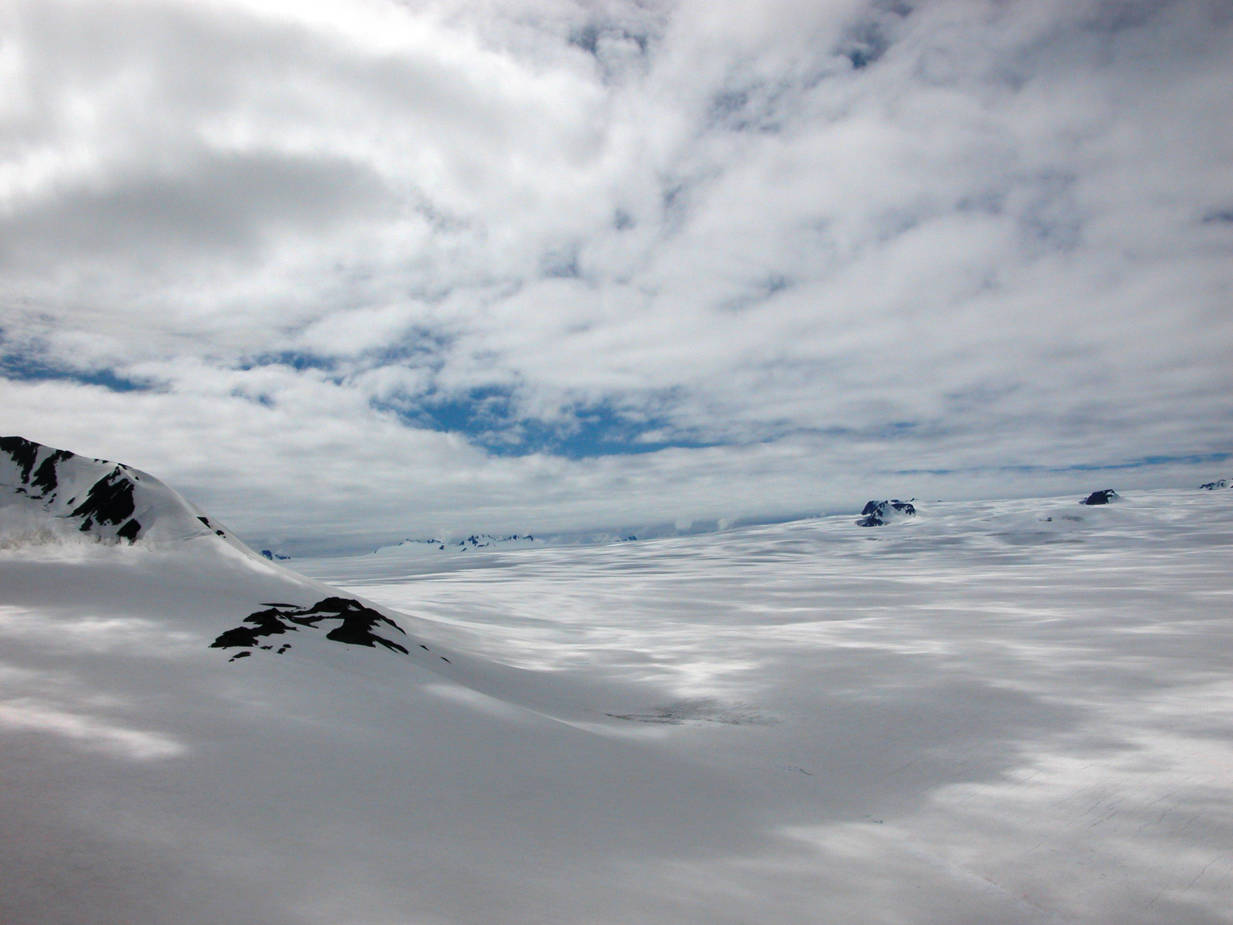There’s something as big as the island of Maui on the Kenai Peninsula that many locals have not seen or not seen well. Unless you’re a pilot, your exposure to this mystery blob has likely been constrained to the hiking trail at Exit Glacier, or perhaps to viewing the tidewater glaciers in Northwestern Fjord from a commercial tour boat, or perhaps to the edge of Skilak Glacier if you’re hunting sheep or goat. These glaciers, as big as they seem, are three slivers among the more than 30 glaciers that feed off the Harding Icefield.
One of four icefields remaining in the United States, the Harding Icefield is the largest wholly within U.S. boundaries. It covers over 700 square miles, stretching more than 50 miles from the Resurrection River southward to the divide in the Kenai Mountains between Bradley Lake and Nuka Bay. The icefield embraces Tuuli Peak, the highest point in the Kenai Mountains at 6,612 feet above sea level, suggesting that the Harding is likely a mile deep in some places.
We need all that ice. It’s easy to forget that the freshwater trapped there is the lifeblood of so many of our glacially fed lakes and rivers and streams in which our salmon spawn. Meltwater from the Harding Icefield feeds the Fox River and Sheep Creek that form the headwaters of Kachemak Bay. Tustumena Glacier is the headwaters of the Kasilof River. The icefield feeds the Killey River, Skilak Lake and Russian River, all tributaries of the Kenai River. It feeds the Resurrection River at the headwaters of Resurrection Bay and the countless high-gradient mountain streams that support pink salmon before cascading into the fjords along the Gulf of Alaska.
The Harding Icefield has been melting since the Wisconsin Ice Age, known locally as the Naptowne Glaciation. At its peak, some 23,000 years ago, it completely covered the Kenai Peninsula except for a few big nunataks, the Caribou Hills, a small patch on the Tustumena benchlands, and the area around Big Indian Creek in the northwestern Kenai Mountains.
And it has been mostly melting since then with some obvious exceptions like the Little Ice Age when the northern hemisphere cooled over the five centuries leading up to the 1850s. The problem is that the Harding Icefield seems to be melting faster now. Bud Rice, at the time a University of Alaska Fairbanks graduate student, used aerial photos to estimate a 5 percent loss in surface area between 1950 and 1985.
Over roughly that same period, other researchers estimated the average ice loss was about 70 feet, or about 0.47 meters in elevation per year. A recent paper published in Geophysical Research Letters, however, estimated the Harding Icefield lost 0.72 meters in elevation per year in the 1990s, a 50 percent increase in thinning rate. This cumulative ice loss over those five decades from the Harding Icefield represents 1 percent of the total contribution of all mountain glaciers worldwide to rising seas!
Not surprisingly, this accelerating ice melt is due to rapidly warming air temperatures. But here’s a weird twist to this story. There’s a species of green alga (Chlamydomonas nivalis) that lies dormant under the snow during winter.
In the spring, the algae germinate in response to increased light and meltwater, sending flagellated cells with little tails that “swim” toward the surface of the snow. Here, these algal cells lose their tails and become red due to a secondary carotenoid pigment that protects the cells from intense visible and ultraviolet radiation. This red-colored snow, often to a depth of 10 inches, is called watermelon snow or red snow. Small invertebrates like ice worms and springtails feed on this red alga.
But the salient piece to this story is that watermelon snow reflects less light than plain snow and so heats more in the summer sun. This, of course, means more meltwater and larger algal blooms, which in turn heats the snow even more.
Several Alaska Pacific University researchers set out to figure out how much this algal growth contributes to faster melting of the Harding Icefield by applying fertilizer and water to experimental plots in Kenai Fjords National Park. The fertilizer simulated increasing levels of nutrient input from atmospheric deposition. Their findings, recently published in Nature Geoscience, showed that watermelon snow, which covers more than a third of the icefield, increased total snowmelt by 17 percent!
The Harding Icefield is a remnant of a much colder, prehistoric climate and becoming increasingly unique as mountain glaciers and persistent snowfields disappear around the globe. In the short term, some of our larger glacial rivers like the Resurrection or the Kenai will receive more meltwater input from the Harding as our climate warms. But smaller watersheds like the Killey River are likely to become more rainwater dependent as the Harding recedes from their headwaters on the western slopes of the Kenai Mountains.
Anyway, while the Harding Icefield is in no danger of disappearing anytime soon, don’t pass up an opportunity to fly over it if you haven’t already. Once you see it, you’ll understand why this white, vast landscape is so special.
Dr. John Morton is the supervisory biologist at Kenai National Wildlife Refuge. Find more information about the Refuge at http://www.fws.gov/refuge/kenai/ or http://www.facebook.com/kenainationalwildliferefuge.

